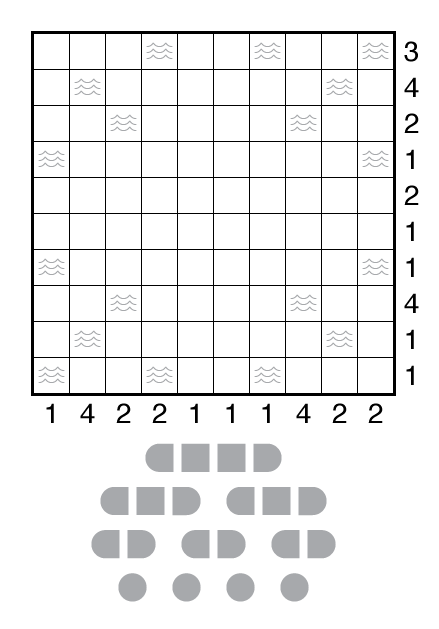Battleships by Thomas Snyder

or solve online (using our beta test of Penpa-Edit tools; use tab to alternate between ship placement and shading modes. In ship placement mode, right click gives sea, left click gives circle/square, left click and drag for rounded ships.)
Theme: High Seas
Author/Opus: This is the 155th puzzle from Thomas Snyder, aka Dr. Sudoku.
Rules: Standard Battleships rules. Use the indicated fleet.
Answer String: For each row from top to bottom, enter the number of the first column from the left where a ship segment appears. If the row is empty, enter 0. Enter these numbers as a single string with no separators.
Time Standards (highlight to view): Grandmaster = 3:00, Master = 4:15, Expert = 8:30
Solution: PDF
Note: Follow this link for other classic Battleships. If you are new to this puzzle type, here are our easiest Battleships to get started on.

Was there any particular tricks to this one? The way I ended up doing it was to try all locations for 4 ship, then 3 ship, which ended up being quite messy.
My method wasn’t much better, but used the fact that there are 5 rows/columns for the three ships 3 squares or larger. The top and bottom 4 can only house one of them, because there isn’t room for both. Then I had to take a long excursion into showing that the left and right 4 could only house one of them as well. After that, it was smooth sailing.
I had to bifurcate, and the path I chose first happened to solve it. Not very satisfying. Were there some deductions I missed?
Scott’s view of the puzzle is pretty close to the intended one, with a 3-unit ship in the first row being the first deduction of consequence because the paired 4s in the rows and in the columns cannot both hold long ships. An earlier version (that did not completely work) had just 1 clues in R56 and C56 and would have made the starting point easier to prove but unfortunately other conflicts kept that from working perfectly.
Yeah, the two in R5 really threw me. I was convinced that the puzzle was pointing me to put the three-boats in C2,R3-5 and C8,R5-7 and I wouldn’t let go of that for a while. Guess I’m getting stubborn in my old age.
My method was confusion followed by too much misguided bifurcation followed by inevitably finding the correct solution. It was fun, but too much bifurcation is busy work that a mindless computer could do for me.
Looking at Tom’s comments, and then going back into the puzzle, … while I see how the 3 in the top left will inevitably drive these other openings, I fail to see how the 3 there is actually instinctive from an overview, as a 4 along the top 4 line does not immediately eliminate both 3s on the side 4 columns. While I guess others might be able to instinctively see the later downfall of such approach, I can admit to having to bifurcate there vefore seeing its contradiction,
Good fun nonetheless. Very impressed with those who did it at the listed speeds. Just happy to be in the same discussion with such folks.
TheSubro
It’s not an immediate elimination, which may be how I slightly failed the solvers here, but the search space can be reduced to just two options: there are either two vertical big ships in C2 and C8 or there is at most one such vertical ship (which will lead to the conclusion that a three-unit cruiser is in R1). The first might feel like a big search space, but it really isn’t. On the two vertical path, the vertical ships must be a cruiser in R3-5C2 and R5-7C8 which then means the battleship is in R2. There is an immediate contradiction in filling rows 1 and 8 because there aren’t enough cells in the first two columns to get both of those rows up to count. So there aren’t two vertical ships, and a cruiser goes in row 1. Recognizing how constrained the rows and columns are might take some sketch-work, and if you don’t catch onto it at all this will feel like being on some turbulent high seas for sure.
If I edit the puzzle to put a sea into R10C10 and a right ship segment in R1C1 it probably works better.
Having seen the response to this puzzle, I’m going to adapt my recommendations to test-solvers on Battleships. They almost all guess to find the solution as fast as they can (because this is what most logic puzzlers do on this style) but I am going to request they also evaluate a logical path to finding one solution and report if it was satisfactory enough.
My first deduction was actually to determine that the only place for the 4 ship was R2. C2 is easily eliminated (not enough room for 2 more 3 ships), R8 would force the R1 3 ship and leave not enough cells to fill R2, C8 also forces R1 3 ship, which then leaves not enough cells to fill both R2 and R8 (because C5/6 can only hold one segment each).
With R2 being the 4 ship, you know R1C1 has to be filled as otherwise you couldn’t fill R1. This leaves only 5 cells in R8 open, which means R7C8 can’t contain a ship segment. This then forces the R1 3 ship.
In the end this is the same deduction, but from a different perspective. I had hoped a bit that all placements of the 4 ship forcing R1C1 to be a ship segment had opened the puzzle as that wasn’t too hard to see, but it didn’t really. The C8 deduction was a bit too long for visualisation, it’s the only one I actually had to draw out to see.